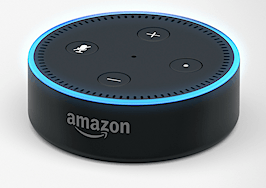Real estate is visual. Real estate is numbers. It’s a simple combination.
Pictures, images, videos and 3D — plus the math on home values, property size and market conditions — help buyers size up prospective houses.
Technology is constantly changing how we interact with these real estate fundamentals and it will soon present the experience in an entirely new and fun way.
Hands-frees computing will take off
Something we wear on our face will become common and shape how the public experiences real estate, making the process more thrilling, extra informative and much easier to navigate.
The combination of virtual and augmented reality and voice recognition will be at the center of so many new products. Ideas that have been around for a long time, but now being integrated and put to a new test by the big tech cats. Take a look at the rush of innovation: Amazon with its new Echo Frames, Facebook’s AR Glasses and the new and improved Google Glass.

The original Google Glass
The original version, circa 2012, of Google Glass was awkward, poorly designed and got panned by users and the press. But innovation has come a long way since version 1.0 of wearable toys.
And even the goofy looking Google Glass was not an epic fail. They’ve become common on factory floors, freeing up workers, making jobs safer and easier.

Google Glass on Factory floor
The future of computing is the marriage of voice and augmented and virtual realities on hands-free devices that rest on our noses like sunglasses.
A house hunt with Facebook AR Glasses or Amazon Echo Frames
I will no longer search for my phone and then fumble around with the touch screen trying to find the right app.

The new Amazon Echo Frames
My eyes will focus on a house (reality) and the interior images appear before me (+ virtual reality) along with the necessary numbers (augmented reality) on price, square footage and an assortment of disclosures and house data. Plus I can use my voice to ask questions and engage in a virtual conversation or get instant visual answers.
“Augmented and virtual reality is going to be the next major computing platform,” Facebook CEO Mark Zuckerberg predicted on stage at the Oculus Connect 6 conference last Wednesday in San Jose. With VR glasses, users can pull up a visual display on top of what’s actually in front of them.

Yves Saint-Laurent
On the same day last week, Amazon announced its Echo Frames.
Thank God: the colorful geek look is gone. Instead, the frames for both Facebook and Amazon look right out of Paris with a sophisticated Yves Saint-Laurent style.
New look, new feel, new functionality
The early versions of wearable glasses were too expensive, clumsy and too obvious. All of those problems are being solved. Plus, new technologies are being tested on this wearable platform including augmented reality, virtual reality and voice recognition.
The arc of innovation here reminds me of the push to put computing on our car dashboards, which has come a long way from GPS to video cams to near driverless automobiles.
Voice technology is making great headway but it is attached to a device in the home or sitting in our pocket, a clunky experience that eyeglasses solve. Wearables give new meaning to mobile.
Almost everything we experience in the real world and the virtual world is spawned by eyes and ears, so hands-free makes so much sense. Will there be other benefits? Will people begin to look up, not down, and maybe even become more social (hopeful)?
Imagine wearables by design-centric Apple

Air Pods
How about the AirPods? They already have more computing power, and the latest version of the AirPods 2 better syncs with Siri and the H1 chip works faster. If not the AirPods, Apple will certainly deploy a new facial technology that someday we’ll all wear.
Before the iPhone was released 11 years ago, the idea of having so much computing power in your pocket was unimaginable.
 And let’s not forget the Apple Watch, no small achievement, monitoring your health, tracking your fitness, a daily reminder and virtual assistant.
And let’s not forget the Apple Watch, no small achievement, monitoring your health, tracking your fitness, a daily reminder and virtual assistant.
Now, it’s only a matter of time before one or all of these wearable technologies takes off and we all think we need them. Then, tons of practical applications will be built, including many for real estate.
Is the emotional real estate connection next?
Imagine computing power that also helps us understand the emotional connection that we have to a home, recreating that intangible that is often the inspiration driving what homes we like and don’t. Not the size of the master bedroom or the view from the back deck, but the feelings and emotions we have towards a particular house.
Last month, Facebook announced its acquisition of CTRL Labs, a gesture recognition start-up that promises to read electrical signals from your spinal cord and turn them into signals that computers can understand.
This sort of computing power will help us find houses that prompt signals that turn us on to a particular beach house or shun a cabin in the woods.
Hard to imagine? Well, ordering a new refrigerator with a few taps on your phone that’s delivered the next morning for free might have seemed impossible in 2006.
All of these innovations are about putting the information that we want right in front us, literally.













